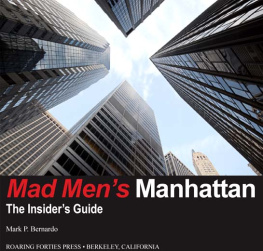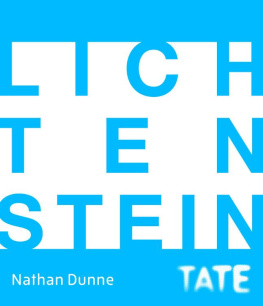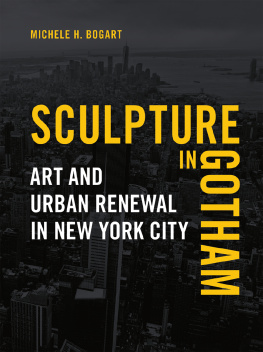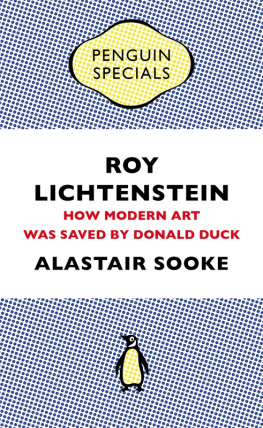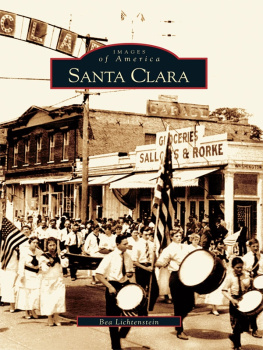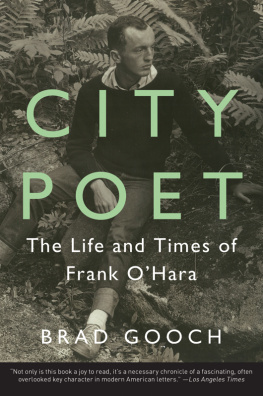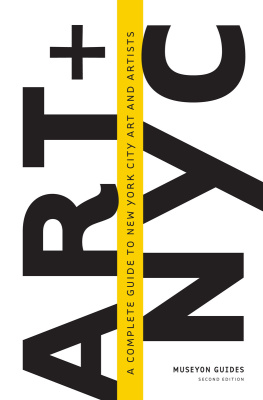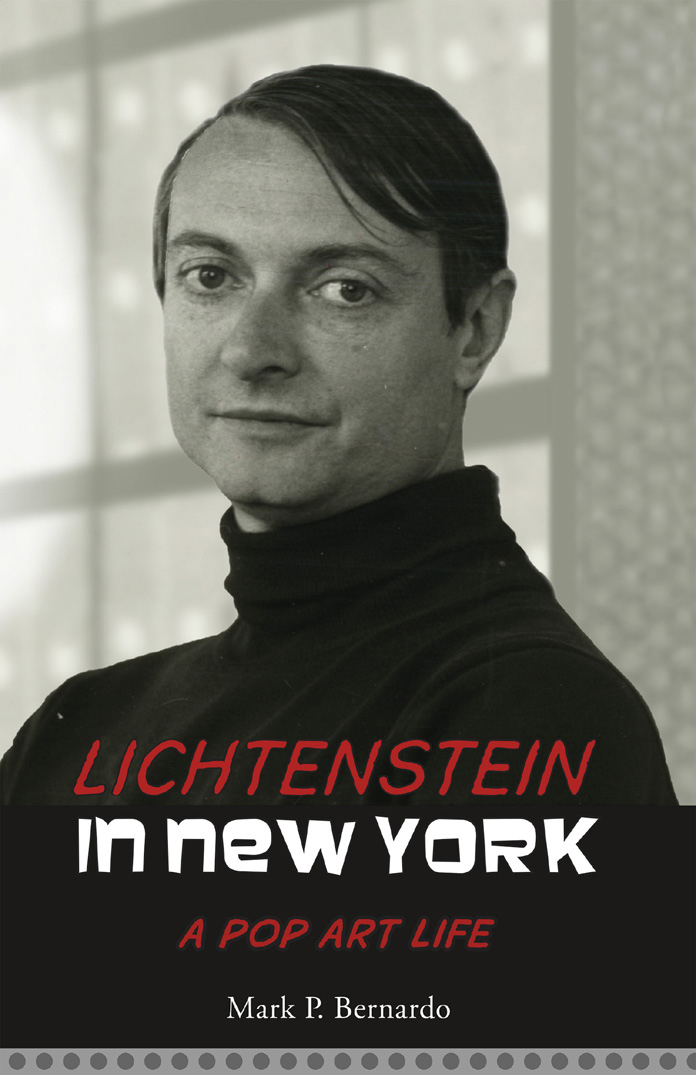LICHTENSTEIN IN NEW YORK

New York City in the 1960s. iStock / Lisa-Blue.
A POP ART LIFE


Roaring Forties Press
1053 Santa Fe Avenue
Berkeley, CA 94706
www.roaringfortiespress.com
Copyright 2017 Mark Bernardo
All rights reserved. Reproduction, modification, storage in a retrieval system or retransmission, in any form or by any means, electronic, mechanical or otherwise, for reasons other than personal use, is strictly prohibited without written permission.
Cover and interior design by Nigel Quinney.
Cover photograph Bernard Gotfryd.
Back cover photograph iStock / Lisa-Blue.
Library of Congress Cataloging-in-Publication Data
Names: Bernardo, Mark P., 1969- author.
Title: Lichtenstein in New York: a pop art life / Mark P. Bernardo.
Description: Berkeley, California: Roaring Forties Press, 2017. | Includes bibliographical references and index.
Identifiers: LCCN 2016057636
Subjects: LCSH: Lichtenstein, Roy, 1923-1997. | Artists--United States--Biography. | Art and society--New York (State)--New York--History--20th century. | New York (N.Y.)--Biography. | BISAC: BIOGRAPHY & AUTOBIOGRAPHY / Artists, Architects, Photographers. | ART / American / General. | ART / Popular Culture.
Classification: LCC N6537.L5 B47 2017 | DDC 709.2 [B] --dc23 LC record available at https://lccn.loc.gov/2016057636
978-1-938901-69-0 (ebook)
CONTENTS

Table of Contents
Guide
When I first pitched this book to Roaring Forties Press, and during the early period of my research, my goal was relatively simple: to examine the career of one of the mid-twentieth-centurys most important artists and to discover how that career was influenced by, and in turn exerted its own influence on, New York City.
My fascination with Roy Lichtenstein stemmed both from my background in comic book publishing and from what struck me as a curious dearth of definitive biographical material on the artist. There is a fairly substantial wealth of critical analysis of his work, but little about the man himself. Other midcentury giants such as Andy Warhol and Jackson Pollock have biographies, but not Lichtenstein, even though his career was longer than theirs.
In the course of my researchwhich involved unearthing contemporary newspaper and magazine accounts of Pop Arts mid-1960s heyday as well as sifting through scholarly tomes on the Pop phenomenon, the 1960s in general, New York Citys history, and the Silver Age of comicsthe project evolved into something more.
This book in no way purports to be that definitive cradle-to-tomb biography of Roy Lichtenstein that Iand surely many otherswould love to see. But what this book does provide, or so I hope, is a more detailed and well-balanced portrait than has been published before, a portrait that not only describes the course of his life but also explores his relationship to his work and probes the controversy that often surrounded that work. This volume also chronicles how America (particularly New York City) and Americans (particularly Lichtenstein) wrought momentous changes in the art world in the second half of the twentieth century. With a career spanning the 1950s heyday of the Abstract Expressionists to the 1990s neo-Pop of Keith Haring and Jean-Michel Basquiat, Lichtenstein is the perfect lens through which to look at a revolutionary era in art.
It is inevitable that at some point in reading this, the reader will notice that this is a book about an artist that contains no art by that artist. The reason for this goes back to that curious lack of biographical material on Lichtenstein. As numerous sources contacted for assistance with this book have confirmed, the Roy Lichtenstein Foundation, managed by the late artists widow, is notoriously and rigidly tight with rights and permissions, not only for reproductions of Lichtensteins artwork but even for pictures of the artist himself. (Some of Lichtensteins detractors, such as those champions of the original comic book illustrators whose four-color panels were appropriated for Lichtensteins canvases, might find this ironic.) For reasons of its own, the foundation seemed not to want to cooperate with my publisher or me on the manuscript. As a result, the book you are about to read is essentially an unauthorizedalbeit heavily researchedbiography. Of course, unauthorized biographies have their own merits, having no agenda except the authors, which in this case is not only to deliver that previously mentioned well-balanced portrait but to do so in a way that engages and informs both art world novices and Pop Art aficionados.
A Google search will turn up any of the works mentioned in this book, and many New York City museums (and a few other city landmarks, as youll discover in chapter 8) offer a glimpse of some of the most famous works. Assuredly, inspiring the reader to make such pilgrimages is another goal of this book. For those interested not just in Lichtensteins art but in seeing it next to the original comics art that it was based on, I highly recommend David Barsalous remarkable website, Deconstructing Roy Lichtenstein (https://www.flickr.com/photos/deconstructing-roy-lichtenstein/; http://davidbarsalou.homestead.com/LICHTENSTEINPROJECT.html; https://www.facebook.com/groups/230408213304/), which was immensely helpful in providing background detail for this book. I am also indebted to David for providing some of the art in this book.
As the reader will discover, comics art (or art from advertisements) appears at the start of several of the following chapters. The reason for including these wonderful illustrations is not to draw direct parallels between Lichtensteins work and the work of artists working in the comics industry. They are included for three different reasons. One is to provide a visual acknowledgment of the undeniable fact that Lichtenstein (in his best-known canvases) and these other artists were working in a similar vein, producing self-evidently similar images, albeit for different reasons. The second is to evoke through the selection of the images that appear at the start of each chapter something of the tenor, flavor, and preoccupations of American life in the period covered in that chapter. And the third reason is that, like Lichtensteins own work, the comics art is simply a pleasure to look atfull of life, wit, adventure, innovation, and those other qualities that one dares to hope are enduring facets of all kinds of American art.
This book would not have been possible without the work of numerous art critics and other writers who have covered Roy Lichtenstein and his decades-long career, among them Fairfield Porter, Lisa Phillips, Michael Lobel, Max Kozloff, Paul Richard, Dorothy Seiberling, John Canaday, Grace Glueck, Hilton Kramer, and Calvin Tomkins, as well as many others whose insights helped me form a more complete picture of this enigmatic artist and his work. I owe many thanks to the aforementioned David Barsalou for his invaluable assistance to my research and for his advocacy of the comics illustrators whose own contributions to Lichtensteins canon might have otherwise been overlooked. Much gratitude is due to Deirdre Greene and Nigel Quinney at Roaring Forties Press, who rolled the dice years ago on a first-time author and steered this project to the finish line through some significant obstacles. Thanks also to my high school and college art and art history instructors, who stoked the fires of interest way back when, and to my parents, who were way more supportive than many would have been when I expressed an interest in pursuing a career making comic books in the big city.


